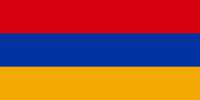 Armenia /ɑrˈmiːniə/ (Armenian: Հայաստան, transliterated : Hayastan, IPA: [hɑjɑsˈtɑn]), officially the Republic of Armenia, is a landlocked mountainous country in the Caucasus region of Eurasia. Situated at the juncture of Western Asia and Eastern Europe, it is bordered by Turkey to the west, Georgia to the north, the de facto independentNagorno-Karabakh Republic and Azerbaijan to the east, and Iran and the Azerbaijani exclave of Nakhchivan to the south.
Armenia /ɑrˈmiːniə/ (Armenian: Հայաստան, transliterated : Hayastan, IPA: [hɑjɑsˈtɑn]), officially the Republic of Armenia, is a landlocked mountainous country in the Caucasus region of Eurasia. Situated at the juncture of Western Asia and Eastern Europe, it is bordered by Turkey to the west, Georgia to the north, the de facto independentNagorno-Karabakh Republic and Azerbaijan to the east, and Iran and the Azerbaijani exclave of Nakhchivan to the south.
A former republic of the Soviet Union, Armenia is a unitary, multiparty, democratic nation-state with an ancient and historic cultural heritage. The Kingdom of Armenia was the first state to adopt Christianity as its religion in the early years of the 4th century (the traditional date is 301). The modern Republic of Armenia recognizes the Armenian Apostolic Church as the national church of Armenia, although the republic has separation of church and state.
Armenia is a member of more than 40 international organisations, including the United Nations, the Council of Europe, the Asian Development Bank, the Commonwealth of Independent States, the World Trade Organization, the Organization of the Black Sea Economic Cooperation, and La Francophonie. It is a member of the CSTO military alliance, and also participates in NATO’s Partnership for Peace (PfP) programme. In 2004 its forces joined KFOR, a NATO-led international force in Kosovo. It is also an observer member of the Eurasian Economic Community and the Non-Aligned Movement. The country is an emerging democracy. Armenia is classified as a country with medium human development and 10.6% of the population live below the international poverty line of US$1.25 a day.
The Republic of Armenia is a successor state to a historical region in Caucasia. Historical Armenia’s boundaries have varied considerably, but old Armenia extended over what are now northeastern Turkey and the Republic of Armenia. The area was equivalent to the ancient kingdom of Urartu, which ruledc. 1270 – 850 BCE. It was later conquered by the Medes and Macedonia and still later allied with Rome.
Armenia adopted Christianity as its national religion c. 300 CE. For centuries the scene of strife among Arabs, Seljuqs, Byzantines, and Mongols, it came under the rule of the Ottoman Empire in 1514 – 16. Over the next centuries, as parts were ceded to other rulers, nationalism arose among the scattered Armenians; by the late 19th century it had caused widespread disruption. Fighting between Ottomans and Russians escalated when part of Armenia was ceded to Russia in 1828, and it continued through World War I (1914 – 18), leading to genocide against Armenians (see Armenian massacres).
With the Ottoman defeat, the Russian portion became part of a Soviet republic in 1922. Armenia was established as a constituent republic of the U.S.S.R. in 1936. The U.S.S.R. began to dissolve in the late 1980s, and Armenia declared its independence in 1991. In the years that followed, it fought Azerbaijan for control of Nagorno-Karabakh, a conflict that continued despite attempts to settle it. Large numbers of Armenians left the country in the 1990s following an economic downturn, and many stayed away even after the economy began to improve.
The Armenian dance heritage has been one of the oldest, richest and most varied in the Near East. From the fifth to the third millennia B.C., in the higher regions of Armenia there are rock paintings of scenes of country dancing. These dances were probably accompanied by certain kinds of songs or musical instruments. In the fifth century Moses of Khorene (Movsés Khorenats’i) himself had heard of how the old descendants of Aram (that is Armenians) make mention of these things (epic tales) in the ballads for the lyre and their songs and dances.
Agriculture holds a significant place in Armenia’s economy, employing almost half of its population. Wine grapes, citrus fruits, vegetables, and livestock are the main agricultural products; fishing is also important. Armenia has deposits of copper, gold, molybdenum, bauxite, and zinc, which provide the basis for a chemical industry. Salts and other minerals have enabled health resorts to thrive. Diamond processing, nonferrous metallurgy, microelectronics, food processing, and the manufacture of electrical equipment, machinery, textiles, and the famous Armenian brandies and wines are also among the republic’s industries. The annual value of Armenia’s imports is much greater than that of its exports. The main trading partners are Russia, Germany, Belgium, the United States, and Israel.
Notes from Wikipedia and Answers.com









